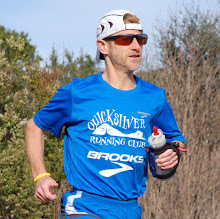In South California, they have a separate group which organizes its own ultra/mountain/trail Grand Prix. It counts 46 members and 48 ultra events in the year, phew!
It is my 11th year competing in our local Mountain Ultra Trail (MUT) Grand Prix. In 2006, Way Too Cool was my first ultra race and I didn't even know the existence of such a competition. I registered to USATF in the middle of the year and got my first points at Helen Klein 50-mile and Quad Dipsea. That got me quite hooked and I won 9 straight Age Group Grand Prix since...
2015 was such an amazing year again for my running, I even logged a record-breaking 570 points (I shared that in my review of 2015 but I published it on New Year's eve so this post got very few visitors, everybody being busy partying! ;-). Not only a personal record but I believe an all-time one. Granted, fastest runners usually don't focus on the Grand Prix as much as I've done all these years...
Anyway, this Saturday is our annual Long Distance and Ultra Running award banquet but I can't attend because I'm already in Vegas for one of our largest IBM conference with 25,000 participants. Since I got questions from people who recently joined our Quicksilver club and ultra running team, I thought I'd illustrate the rules of the Grand Prix. As a matter of fact, this Grand Prix is in its 30th year, an amazing milestone under the leadership of our co-chairs Bill Dodson and Hollis Lenderking, with Gary Wang having done the super meticulous job of keeping scores all these years (see his amazing RealEndurance.com website, and chip in a few bucks if you can). After decades of volunteering with such dedication, they will happily pass the reins to the next generation and change will likely come to the list of events at least.
Indeed, for the past 10 years which I participated, the races have been pretty much the same and that has become of a problem as a few of them are not subject to very competitive lotteries dues to too many applicants (most notably: Western States, Way Too Cool, Tahoe Rim Trail, Miwok).
So, what did this Grand Prix consist in last year? Let's look at the individual version first:
- A series of 17 events from February to November and ranging from 28 miles to 24 hours;
- A few events offer different distances (e.g. 50K, 50 miles and 100K at Ruth Anderson) but you can only score in one distance for an event;
- Each distance as a coefficient/multiplier, from 1 for 50K to 3.3 for 100-milers or 24-hour races assuming you ran more than 100 miles. That coefficient is used to compute the number of points, a first place being worth 40 for a 50K for age groups between 30 to 59 years, 20 below 29 and over 60. 40 for 1st place, then 31, 24, 19, 16, 14, 12, then on minus 1 down to 1.
- In addition to this, you can get a bonus for improving an age group course record. 10 for races/courses less than 10-year old, 20 otherwise (for the 30-59 age groups, or half that for the others). [January 2017 update: this bonus got dropped by mid 2016.]
- But you can't score 17 races, only 7 counts, and not just the 7 highest scores. To ensure that you don't kill it with a few 'hundos' (100-milers), you can only score 1 100-miler (or 24-hour), no more than 3 scores can be for 100K or longer races, and at least 2 of the 7 have to be 50Ks.
To further illustrate, here would be the optimal/maximum configuration:
- 1 100-mile win, 2 100K wins, 2 50-mile wins, 2 50K wins that is 132 + 2 * 80 + 2 * 64 + 2 * 40 = 500
- And 7 age group records of more than 10 years for 140 additional points, and a total of 640.
Now, out of the 22 races last year, 11 were run on courses which changed over the past 10 years, so that limited the options and there was no way to get to this theoretical 640 maximum. In 2015, I got the 500 points and 70 bonus points.
Detailed rules can be found on the PA USATF website. And the result archives in two places: most recent years (from 2014 on) and 2002-2013.
Oh well, I must have lost you already with all these numbers, didn't I? Indeed, as Agnès reminds me before each race, we do that for the fun of it, at least not for the money, if even for the points...! But it's healthy to have some specific goals to chase.
By the way we were 249 participants in the MUT Grand Prix, quite a number. That of course only counts runners who live in the area and pay their USATF dues.
I'm sorry to miss the banquet and especially the guest speakers, Olympian Kim Conley and renowned podiatrist Dr. Amol Saxena. If you haven't registered yet, here is the Eventbrite link from the hosting Strawberry Canyon Track Club. And I look forward to another blogger covering and reporting on the event since I can't do it this year.




.jpg )

No comments:
Post a Comment